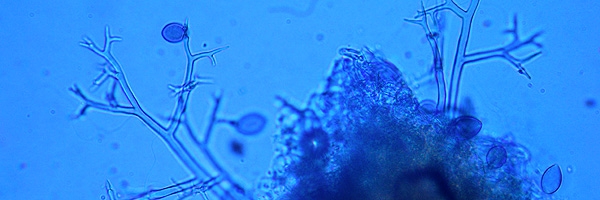
Pseudoperonospora cubensis (Berk. & M.A. Curtis) Rostovzev, (1903)
Downy mildew
- classification : Chromista*, Oomycota, Oomycetes, Peronosporomycetidae, Peronosporales, Peronosporaceae
- synonymies : Peronoplasmopara cubensis (Berk. & M.A. Curtis) G.P. Clinton [as ' cubense '], (1905) [1904] ;
Peronospora cubensis Berk. & M.A. Curtis, (1868) [1869] ;
Plasmopara cubensis (Berk. & M.A. Curtis) C.J. Humphrey, (1891)
- English name: downy mildew ; Spanish name: mildiù
Pseudoperonospora cubensis has climatic requirements that allowed it to first colonize the tropics and subtropics of the globe. It is now very widely distributed in the world, on all continents and in much more northern latitudes. It is reported in North and South America (Canada, USA, Mexico, Brazil, Argentina ), Asia (China, Taiwan, North and South Korea, Indonesia, India ), Africa (Algeria, Cameroon, Senegal, Niger, Ethiopia ), in many countries in Western Europe (Italy, Spain, Germany, England ) as well as in the East (Czech Republic, Poland, Albania, Belarus, Ukraine, Moldavia, Baltic Republic, Russia ), in the Mediterranean basin (Egypt, Israel, Macedonia, Greece, Jordan ).
In these countries, mildew affects both field crops and those under cover. In many cases it causes very damaging damage to various Cucurbitaceae: cucumber, melon, Cucurbita spp . , watermelon, but also on other Cucurbitaceae, cultivated or not, at least forty species. Depending on the country, the range of species showing symptoms varies depending on the strains of P. cubensis prevalent and their virulence.
The mildew agent has been present in France for many years where its attacks on cucumber and melon are particularly feared by producers. It now affects zucchini very occasionally, some attacks have been observed in the south-west in particular. This situation could be explained by an evolution of the strains of mildew present in France.





